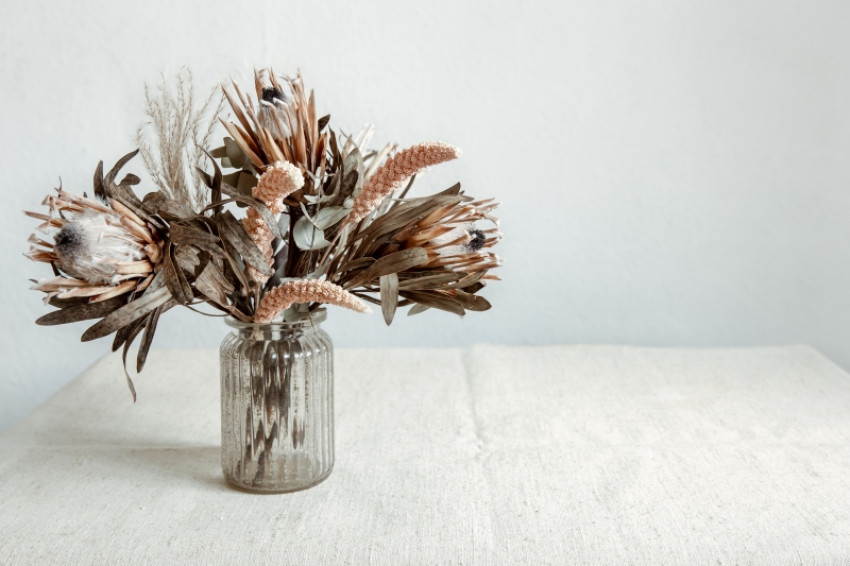
Wooden blooms have gained significant popularity in crafting and wedding decoration, captivating numerous individuals with their exceptional aesthetic appeal and impressive adaptability. These durable and environmentally-friendly flowers offer a remarkable substitute for fresh blooms, and their beautiful feature lies in their capacity to be dyed in a wide range of vivid hues. Making dyed flowers offers many possibilities, allowing individuals to align their wedding theme, create customized home decor, or produce distinctive gifts.
If you want to become a professional in this domain, this comprehensive guide aims to explain how to dye wood flowers. Following these steps, you can explore the transformative power of color and imbue your creations with a personalized touch that reflects your unique style and artistic expression.
How to Dye Wood Flowers?
1. To Make Dyed Flowers, You Should Gather Your Supplies and Choose the Perfect Dyeing Method
Before understanding how to dye wood flowers, you must ensure you possess all the essential materials readily available. Create an assortment of wooden blooms, either unprocessed and organic or pre-colored, based on personal inclination. In addition, it is advisable to acquire fabric dye or acrylic paint, a receptacle for mixing, protective gloves, stirring implements, and protective sheets or newspapers to safeguard the work surface and reduce potential untidiness.
When selecting fabric dye, choosing a water-based and non-toxic variant is advisable. On the other hand, acrylic paint provides a denser texture and a wide range of vivid colors, facilitating artistic experimentation.
In dyed flowers, two fundamental techniques exist for attaining the desired outcome: immersion and painting. The immersion technique entails completely submerging the wooden blossoms in a dye solution, facilitating the absorption of colors and resulting in a uniform and consistent shade. In contrast, using a brush, the painting technique involves directly applying dye or paint onto the floral surface. This method affords greater precision in color application, facilitating the creation of intricate designs and enabling precise color placement. Select the methodology congruent with your artistic vision and suitable for attaining the desired outcome.
2. Prepare the Dye Mixture and Test for Perfection
It is imperative for people who adopt the immersion method to adhere to the instructions provided on the selected fabric dye to prepare the dye mixture properly. Typically, it is necessary to combine the paint with water to attain the desired level of color intensity. Thus, it is recommended to stir the mixture thoroughly to achieve a uniform distribution of color and ensure consistency in the appearance of all the dyed flowers. This will help to evenly distribute the color throughout the mixture, resulting in all wood flowers attaining the same visually striking hue.
Alternatively, should you opt for the painting technique, it is advisable to dilute acrylic paint with water to achieve the desired viscosity, thereby facilitating a smooth and enjoyable paint application.
Before fully understanding how to dye wood flowers, initiating a preliminary experiment involving a solitary wooden bloom is advisable. This experiment aims to familiarize participants with the behavior of dye or paint on the surface of a flower and the resulting appearance of color after it has dried. By undertaking this experiment, you can enhance your comprehension of modifying the dye composition or paint viscosity to attain the desired hue.
3. Explore the Immersion Method and the Painting Method
For individuals who adopt the immersion method, the procedure entails delicately submerging the wooden flowers into the dye solution, guaranteeing their complete immersion to attain a uniform and comprehensive coloring. Permit the flowers to immerse for a brief duration, facilitating their absorption of the vibrant pigments of the dye https://allcraftythings.com/basic-dyes-how-to-make-natural-pigments-at-home/. The time of dye immersion can be adjusted according to individual color intensity preferences, allowing for the attainment of more profound and rich tones in the flowers.
After achieving the desired color saturation, carefully extract the flowers from the dye solution, ensuring to eliminate any surplus liquid by gently shaking them. Subsequently, position the dyed flowers on a safeguarded surface, allowing them to undergo complete drying.
For individuals who favor the painting technique when they decide to know how to dye wood flowers, the procedure involves carefully submerging a brush into the dye or paint solution and meticulously applying it accurately onto the wooden flower’s surface. Apply the dye or paint to the petals, leaves, and intricate details, ensuring a uniform and glossy color distribution on all surfaces and crevices. The painting technique gives people an enhanced degree of command. It is well-suited for creating intricate patterns or the deliberate arrangement of hues to achieve a visually captivating and harmonious result.
4. Embrace the Allure of Ombre Effects and Get Used to Setting the Colors
Suppose you desire an ombre effect https://www.wikihow.com/Paint-an-Ombre-Canvas characterized by a smooth transition of colors from light to dark or from one color to another. In that case, the initial step involves fully immersing the entire flower into the dye mixture. Therefore, to achieve the desired gradient effect, it is recommended to carefully and gradually lift the flower out of the dye.
Imagine you wish to achieve a more nuanced ombre effect when learning how to dye wood flowers. In that case, you may only immerse a section of the flower into the paint, allowing it to dry before repeating the procedure with a more intense dye. Utilize your artistic creativity to craft intricate and captivating ombre wood flower artworks.
After the dyeing process is concluded, ensuring that the dyed flowers undergo a thorough drying phase is imperative, guaranteeing the establishment and enhancement of the colors. Position the items on a safeguarded surface or utilize a drying rack to facilitate adequate airflow, thereby accelerating the drying procedure and maintaining the vibrancy of the colors. Therefore, to optimize color retention and bolster longevity, it is advisable to employ mild heat to set the color. It is advisable to exercise caution during this particular phase, particularly when handling pre-dyed or fragile wood flowers, to prevent any undesirable consequences.




